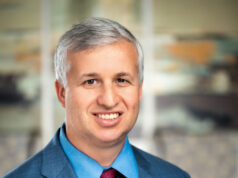
Discussion during the opening day of the Charing Cross (CX) 2021 Digital Edition emphasized the potential of Philips’ Fiber Optic RealShape (FORS) technology to reduce radiation and ease technical success, with moderator Gustavo Oderich, MD, professor and chief of vascular and endovascular Surgery at the University of Texas’ McGovern Medical School in Houston, suggesting that “radiation will be a thing of the past” thanks to this new technology.
Other key takeaways during a session on controversies on the abdominal aortic space included a ringing endorsement that endoanchors have a part to play in the treatment of challenging necks, and consensus among the panel that parallel grafts should be used as little as possible in this hostile anatomy. CX 2021 is being held online April 19–22.
Marc L. Schermerhorn, MD, chief of vascular and endovascular surgery at Beth Israel Deaconess Medical Center in Boston gave a presentation on the “disruptive” technology of FORS, which opened a panel discussion on the topic of radiation. Oderich stated that FORS “addresses a major area of need, which is the ability to look at the anatomy on any view we want without being radiated,” highlighting that the technology offers both an ease of technical success and parallel reduction of radiation. Looking ahead, he posited: “Radiation is going to be a thing of the past.”
Endoanchors in challenging necks come of age
In a Podium 1st presentation, William Jordan, MD, chief in the division of vascular surgery and endovascular therapy at Emory University School of Medicine in Atlanta, revealed preliminary five-year data from the primary arm of the ANCHOR registry (Aneurysm treatment using the Heli-FX EndoAnchor system global registry). This is a multicenter, prospective study designed to capture real-world usage of the Heli-FX EndoAnchor system (Medtronic) in patients with challenging AAA anatomy, particularly those with hostile aortic neck anatomies. Jordan concluded that, out to five years, patients with hostile necks “may have acceptable durability when the EndoAnchor fixation method is used, particularly at the index operation.”
Showcasing the practical use of endoanchors in the challenging neck anatomy, Giovanni Pratesi, MD, a vascular surgeon in Genoa, Italy, presented an edited case, with postoperative computed tomography angiography (CTA) showing complete aneurysm exclusion in a challenging proximal aortic neck.
Majority against standard EVAR in challenging necks
A CX Debate addressed another pressing issue regarding hostile neck anatomy—that being whether standard endovascular aneurysm repair (EVAR) can be used in most challenging necks. Colin Bicknell, BM MD, a consultant vascular surgeon in London, England, stood for the motion, while Vascular Society of Great Britain and Ireland (VSGBI) president Michael Jenkins, MBBS, also a consultant vascular surgeon in London, put forward the counterargument.
“There is significant, successful innovation to ensure short-term sealing and prevent long-term complications,” argued Bicknell, who resolved that EVAR is therefore appropriate for “most” patients with AAA who prefer this approach. Jenkins, on the other hand, contended that standard EVAR cannot be used in most challenging necks “because it does not work”. He elaborated: “It is outside IFU [instructions for use], aortic neck dilatation leads to loss of seal, and sac expansion causes positional change and effacement of seal zone.” He added that while adjuncts may help transiently, they are not durable. “What may have been heroic 10 years ago, perhaps maverick five years ago, now is criminal”, Jenkins concluded.
Following the debate, polling revealed that 71% of the CX 2021 audience disagreed with the motion that standard EVAR can be used in most challenging necks.
Parallel grafts consensus
Also addressing a challenging neck controversy, Alexander Zimmermann, MD, a vascular surgeon in Zürich, Switzerland, gave a presentation on parallel graft use in the anatomy of a hostile neck, focusing in particular on “disappointing” clinical results thus far. He concluded that, in the majority of cases, he aims to “stay away” from using such grafts in challenging necks; the moderators were in agreement, with Ian Loftus, MBChB, a consultant vascular surgeon in London, voicing that he would only use parallel grafts in “very selective emergency cases” and Roberto Chiesa, MD, a vascular surgeon in Milan, Italy, stating that he uses parallel grafts as infrequently as possible.










